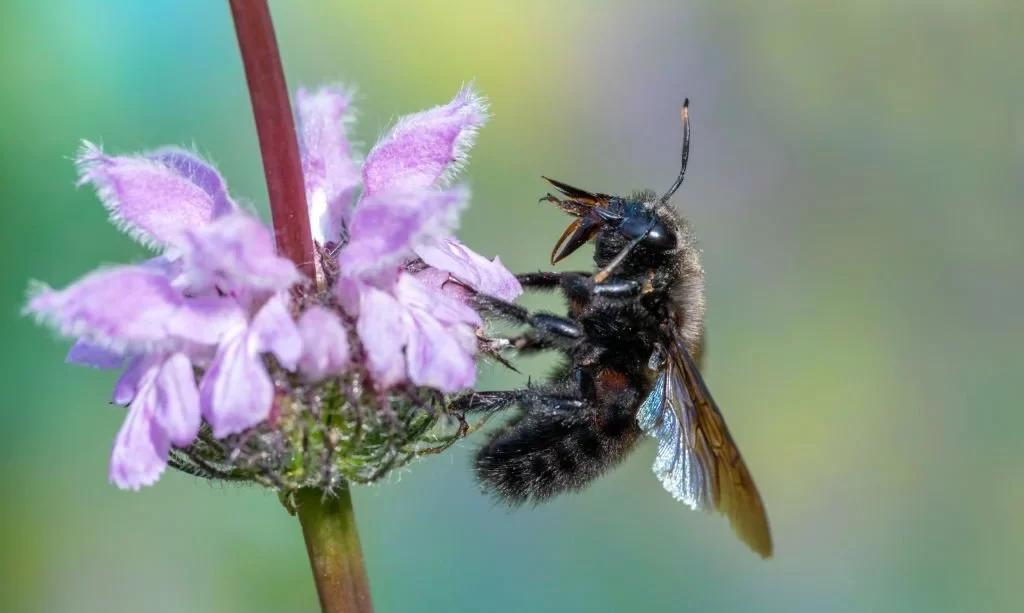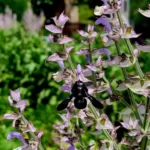In the bustling world of insects, there exists a creature that often goes unnoticed, yet it possesses a unique charm and an intriguing reputation – the carpenter bee. While honeybees and their honey-making prowess have enjoyed the limelight for centuries, carpenter bees have quietly carried out their vital roles in the natural world. But here’s the question that frequently arises among those curious about these buzzing wonders: Do carpenter bees make honey like their better-known relatives, honeybees? To uncover the truth behind this query, we embark on a journey through the world of carpenter bees and their fascinating way of life.
Meet the Carpenter Bees
Carpenter bees, often mistaken for bumblebees due to their robust appearance, are a distinct group of solitary bees. They can be found in various parts of the world, and their name is derived from their remarkable nesting behavior. Unlike honeybees, which live in highly organized colonies, carpenter bees are solitary insects, each female building and maintaining her nest independently. These remarkable insects are known for their impressive carpentry skills, hence their name.
Carpenter bees are typically large, with shiny, black or metallic blue bodies and, in some species, striking yellow markings. Their appearance may vary depending on the specific type of carpenter bee, but they share a common trait: an uncanny ability to drill into wood to create their nests. This unique characteristic sets them apart from honeybees, which construct intricate hives. To truly understand carpenter bees and their honey-making capabilities, it’s essential to delve deeper into their lifestyle and habits.
The Honey-Making Conundrum
To appreciate the distinction between carpenter bees and honeybees, we must first unravel the enigma of honey production. In the world of bees, honeybees are renowned for their complex social structure and hive-building prowess. These industrious insects collect nectar from flowers, a sugary liquid produced by plants, and transform it into honey. The process involves regurgitating and dehydrating the nectar within the hive. The result is the golden, viscous substance that humans have cherished for centuries.
However, the honey-making story takes a different turn when we turn our attention to carpenter bees. Despite their impressive carpentry skills and essential role in pollination, carpenter bees do not partake in honey production as honeybees do. Their life cycle and nesting behavior are distinctly different, and understanding these nuances is crucial to dispelling the myth that carpenter bees make honey. So, let’s explore the fascinating lifestyle of carpenter bees to shed light on this conundrum.
Carpenter Bee Lifestyle
Carpenter bees, in contrast to the highly organized colonies of honeybees, are solitary insects. Each female carpenter bee is an independent builder and caretaker of her nest. What truly sets carpenter bees apart is their unique nesting behavior. They are aptly named for their remarkable carpentry skills, as they bore into wood to create nesting galleries. This behavior has led to occasional concerns among homeowners when carpenter bees choose to tunnel into wooden structures, such as decks or eaves, for their nests.
These solitary bees construct individual nests within the wood, where they lay their eggs and provide food for their offspring. Unlike honeybees, which store honey to sustain their colonies through the winter, carpenter bees do not produce honey. Instead, they focus on collecting pollen, which serves as a protein-rich food source for their developing larvae. This fundamental difference in nesting behavior and food storage clarifies the reason why carpenter bees are not associated with honey production, despite their incredible carpentry skills. To understand the full scope of carpenter bees’ role in the ecosystem, we must appreciate their dedication to pollen collection and their vital role in pollination, which we will explore further in subsequent sections.
Nectar vs. Pollen
To grasp why carpenter bees don’t make honey, it’s essential to distinguish between nectar and pollen, the two primary substances collected by bees. Honeybees, driven by their communal structure, specialize in nectar collection. Nectar is a sweet, sugary liquid produced by flowers as a reward for pollinators. Honeybees diligently gather nectar and bring it back to the hive, where worker bees convert it into honey through a process of regurgitation and dehydration. This honey serves as their primary source of sustenance.
Carpenter bees, on the other hand, focus their efforts on collecting pollen. Pollen is a vital source of protein that bees require to nourish their developing larvae. Unlike nectar, which is transformed into honey, pollen is stored in the galleries they construct within wood. Carpenter bees are meticulous in their pollen collection, visiting various flowers and transferring pollen grains as they forage, making them essential pollinators.
The Role of Carpenter Bees in Pollination
While carpenter bees may not produce honey, their significance in the natural world cannot be overstated. These diligent insects play a vital role in pollination, contributing to the reproduction of numerous plant species. As they visit flowers in search of pollen, carpenter bees transfer pollen from one flower to another, facilitating fertilization and the production of seeds and fruit. This essential ecological service benefits not only the plants but also the broader ecosystem.
Carpenter bees are particularly effective pollinators for certain plant species with specialized flowers, including those that require buzz pollination. Buzz pollination occurs when bees, including carpenter bees, vibrate their bodies near a flower to release tightly held pollen. This unique ability enhances their efficiency as pollinators for crops like tomatoes, eggplants, and blueberries.
Conclusion
In our quest to uncover the truth about carpenter bees and honey production, we’ve ventured into the fascinating world of these solitary, industrious insects. While they may not craft honey like their honeybee counterparts, their role in the ecosystem as vital pollinators cannot be overstated. Carpenter bees, with their distinctive nesting habits and dedication to pollen collection, contribute significantly to plant reproduction and the abundance of fruits and vegetables we enjoy. So, while honeybees may claim the honey-making spotlight, let us not forget to appreciate the invaluable work of carpenter bees in maintaining the balance of nature.




